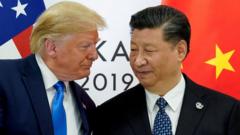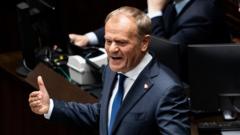The US government has initiated a review of its multi-billion dollar Aukus submarine deal with Australia and the UK to ensure its alignment with the "America First" agenda. Despite concerns, both allies remain optimistic about the pact's longevity amid rising pressures on military spending.
US Reevaluates Strategic Aukus Submarine Agreement Amid 'America First' Policy Shift

US Reevaluates Strategic Aukus Submarine Agreement Amid 'America First' Policy Shift
A new review of the Aukus submarine pact signals a strategic recalibration by the US, which aims to align military partnerships with its national agenda regarding defense spending.
The US has launched a comprehensive review of its significant submarine agreement with Australia and the UK under the Aukus pact. This initiative is part of an effort to align the military alliance with the presidential "America First" policy. Through this agreement, Australia is set to acquire its first nuclear-powered submarines from the US and eventually develop a new fleet thanks to shared technology between the three nations, all aimed at countering China's increasing dominance in the region.
While US defenses are emphasizing this initiative's requirement to meet the current administration's objectives, both Australia and the UK have played down the review's implications, labeling it a customary evaluation under new leadership. The Aukus deal, which is valued at approximately £176bn ($239bn; A$368bn), was solidified in 2021, during a time when the three involved nations were led by different governments.
A US defense representative indicated that this reassessment is pivotal for confirming that the initiative still aligns with the readiness priorities of American servicemembers. As pressure builds from the Biden administration for allies to increase military spending to at least 3% of GDP, both the UK and Australia are under scrutiny to adhere to these demands. While the UK has committed to raising its defense budget to 2.5% by 2028 and subsequently to 3%, Australia's projected increases remain below the US's expectations.
Elbridge Colby, who has been critical of Aukus in the past, will lead the review. Despite rising concerns regarding the efficacy of the agreement, Australian Defence Minister Richard Marles expressed confidence in the deal's continuation, arguing that Australia's need for long-range submarine capabilities remains undeniable. Some voices in Australia advocate for a self-reliant defense strategy; however, Marles reinforced the necessity of adhering to established plans, recalling the previous government's controversial submarine agreement cancellation with France.
An Australian government spokesperson described the review as a standard practice for a new administration, paralleling recent UK evaluations of the pact. The ongoing bipartisan support for Aukus in the US was emphasized, along with Australia's eagerness to maintain collaboration with the current administration.
The UK also expressed support for the review's rationale, underscoring Aukus as a critical defense partnership that enhances stability in the Indo-Pacific and Euro-Atlantic regions. Some analysts contend that the US is justified in reassessing the deal, particularly given its already overstretched naval capabilities. This situation raises uncertainty over whether Australia will utilize the submarines as intended, particularly amid escalating geopolitical tensions over Taiwan.
Should the US reconsider its commitment to the agreement, analysts warn that it could embolden China, which has consistently criticized the Aukus deal as an arms escalation. As the deal progresses, it stands to enhance Australia's military capabilities significantly, marking a substantial leap toward obtaining elite nuclear propulsion technology and enabling long-range strike operations.
The final arrangements under the Aukus initiative include a plan for the US and UK to establish a rotational base of nuclear submarines in Perth, Australia from 2027. Australia would also procure three used Virginia-class submarines from the US, with an option for additional purchases in the following years, ultimately collaborating on the development of a new nuclear submarine model tailored for both the Australian and UK navies.






















